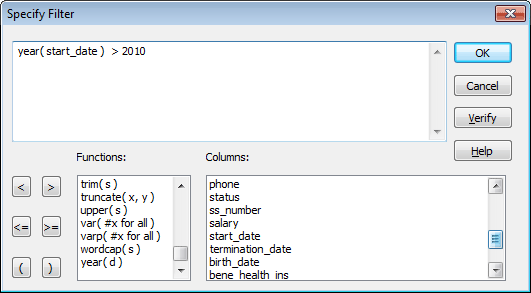You can use WHERE and HAVING clauses and retrieval arguments in the SQL SELECT statement for the DataWindow object to limit the data that is retrieved from the database. This reduces retrieval time and space requirements at runtime.
However, you may want to further limit the data that displays in the DataWindow object. For example, you might want to:
-
Retrieve many rows and initially display only a subset (perhaps allowing the user to specify a different subset of rows to display at runtime)
-
Limit the data that is displayed using DataWindow expression functions (such as If) that are not valid in the SELECT statement
In the DataWindow painter, you can define filters to limit the rows that display at runtime. Filters can use most DataWindow expression functions or user-defined functions.
Filters do not affect which rows are retrieved
A filter operates against the retrieved data. It does not re-execute the SELECT statement.
To define a filter:
-
In the DataWindow painter, select Rows>Filter from the menu bar.
The Specify Filter dialog box displays:
-
In the Specify Filter dialog box, enter a boolean expression that PowerBuilder will test against each retrieved row.
If the expression evaluates to true, the row is displayed. You can specify any valid expression in a filter. Filters can use any non-object-level PowerScript function, including user-defined functions. You can paste commonly used functions, names of columns, computed fields, retrieval arguments, and operators into the filter.
International considerations
The formatting that you enter for numbers and currency in filter expressions display the same way in any country. Changing the regional settings of the operating system does not modify the formatting displayed for numbers and currency at runtime.
For information about expressions for filters, see the section called “Where you use DataWindow expressions” in DataWindow Reference.
-
(Optional) Click Verify to make sure the expression is valid.
-
Click OK.
Only rows meeting the filter criteria are displayed in the Preview view.
Filtered rows and updates
Modifications of filtered rows are applied to the database when you issue an update request.
To remove a filter:
-
Select Rows>Filter from the menu bar.
-
Delete the filter expression from the Specify Filter dialog box, then click OK.
Assume that a DataWindow object retrieves employee rows and three of the columns are Salary, Status, and Emp_Lname. The following table shows some examples of filters you might use.
|
To display these rows |
Use this filter |
|---|---|
|
Employees with salaries over $50,000 |
Salary > 50000 |
|
Active employees |
Status = 'A' |
|
Active employees with salaries over $50,000 |
Salary > 50000 AND Status = 'A' |
|
Employees whose last names begin with H |
left(Emp_Lname, 1) = 'H' |
Setting filters dynamically
You can use the SetFilter and Filter methods in a script to dynamically modify a filter that was set in the DataWindow painter. For information about SetFilter and Filter, see the section called “SetFilter” in DataWindow Reference and the section called “Filter” in DataWindow Reference.



